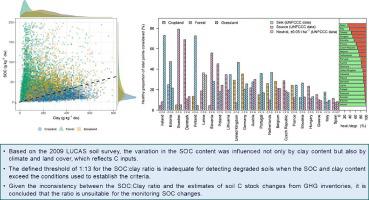Our official English website, www.x-mol.net, welcomes your feedback! (Note: you will need to create a separate account there.)
Is the organic carbon-to-clay ratio a reliable indicator of soil health?
Geoderma ( IF 6.1 ) Pub Date : 2024-03-27 , DOI: 10.1016/j.geoderma.2024.116862 Raisa Mäkipää , Lorenzo Menichetti , Eduardo Martínez-García , Tiina Törmänen , Aleksi Lehtonen
Geoderma ( IF 6.1 ) Pub Date : 2024-03-27 , DOI: 10.1016/j.geoderma.2024.116862 Raisa Mäkipää , Lorenzo Menichetti , Eduardo Martínez-García , Tiina Törmänen , Aleksi Lehtonen

|
Climate action plans under the Paris Climate Agreement and other national commitments aimed at improving soil-based ecosystem services require the operational monitoring of soil carbon (C). The European Union is aiming to enhance soil health, and as part of the proposed Soil Monitoring Law, the European Commission recommends the monitoring of the soil C loss indicator among other soil health indicators. In this study, we evaluate the feasibility of the proposed soil C loss indicator by assessing its performance using the EU-wide 2009 LUCAS soil survey data. The proposed indicator is the soil organic carbon (SOC) to clay ratio, with a threshold value of 1:13. The results are also compared with the C stock changes reported by countries to the climate convention (UNFCCC). Our results reveal that the variation in SOC and clay content at European scale exceeds that of the data used to develop the proposed indicator. We also found that the variation in the SOC content was influenced not only by clay content but also by climate and land-use reflecting C input levels. Therefore, the defined threshold is inadequate for detecting degraded soils if the SOC and clay content are beyond the conditions used to establish the criteria. Furthermore, major discrepancies were observed between the soil carbon stock changes reported by the national greenhouse gas (GHG) inventories and the proportions of degraded soils identified by using the soil C loss indicator. We conclude that employing a single indicator such as SOC:Clay ratio with one threshold value for all soils across various land covers, management practices, and climatic conditions, as defined by the European Commission for the Soil Monitoring Law, is inappropriate for monitoring soil C loss.
中文翻译:

有机碳与粘土的比率是土壤健康的可靠指标吗?
《巴黎气候协定》和其他旨在改善土壤生态系统服务的国家承诺下的气候行动计划需要对土壤碳(C)进行业务监测。欧盟的目标是增强土壤健康,作为拟议土壤监测法的一部分,欧盟委员会建议监测土壤碳流失指标以及其他土壤健康指标。在本研究中,我们通过使用欧盟范围内的 2009 年 LUCAS 土壤调查数据来评估其性能,从而评估所提出的土壤碳流失指标的可行性。建议的指标是土壤有机碳(SOC)与粘土的比率,阈值为1:13。结果还与各国向气候公约(UNFCCC)报告的碳库变化进行了比较。我们的结果表明,欧洲范围内 SOC 和粘土含量的变化超过了用于制定拟议指标的数据的变化。我们还发现,SOC 含量的变化不仅受到粘土含量的影响,还受到反映碳输入水平的气候和土地利用的影响。因此,如果 SOC 和粘土含量超出用于建立标准的条件,则定义的阈值不足以检测退化土壤。此外,国家温室气体(GHG)清单报告的土壤碳储量变化与使用土壤碳流失指标确定的退化土壤比例之间存在重大差异。我们的结论是,按照欧洲土壤监测法委员会的定义,对各种土地覆盖、管理实践和气候条件下的所有土壤采用单一指标,例如 SOC: 粘土比率,并具有一个阈值,不适合监测土壤 C损失。
更新日期:2024-03-27
中文翻译:

有机碳与粘土的比率是土壤健康的可靠指标吗?
《巴黎气候协定》和其他旨在改善土壤生态系统服务的国家承诺下的气候行动计划需要对土壤碳(C)进行业务监测。欧盟的目标是增强土壤健康,作为拟议土壤监测法的一部分,欧盟委员会建议监测土壤碳流失指标以及其他土壤健康指标。在本研究中,我们通过使用欧盟范围内的 2009 年 LUCAS 土壤调查数据来评估其性能,从而评估所提出的土壤碳流失指标的可行性。建议的指标是土壤有机碳(SOC)与粘土的比率,阈值为1:13。结果还与各国向气候公约(UNFCCC)报告的碳库变化进行了比较。我们的结果表明,欧洲范围内 SOC 和粘土含量的变化超过了用于制定拟议指标的数据的变化。我们还发现,SOC 含量的变化不仅受到粘土含量的影响,还受到反映碳输入水平的气候和土地利用的影响。因此,如果 SOC 和粘土含量超出用于建立标准的条件,则定义的阈值不足以检测退化土壤。此外,国家温室气体(GHG)清单报告的土壤碳储量变化与使用土壤碳流失指标确定的退化土壤比例之间存在重大差异。我们的结论是,按照欧洲土壤监测法委员会的定义,对各种土地覆盖、管理实践和气候条件下的所有土壤采用单一指标,例如 SOC: 粘土比率,并具有一个阈值,不适合监测土壤 C损失。



























 京公网安备 11010802027423号
京公网安备 11010802027423号